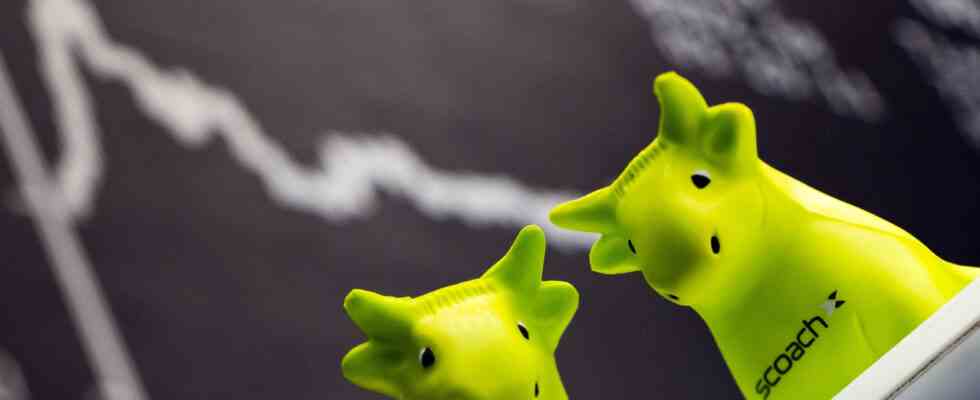analysis
Status: 01/13/2023 1:04 p.m
The DAX got off to a furious start in the new stock market year. Are investors too optimistic or can things still go up? What now speaks for and against rising prices.
Investors grabbed German stocks in the first two weeks of the year like they had not in decades. Since the close of trading on December 30 at 13,924 points, the leading index DAX has recorded a price increase of 8.6 percent at its peak. Yesterday, the DAX crowned its rally at the beginning of the year and cleared the 15,000 point hurdle with apparent ease. At the end of the week, the next round mark of 15,100 points also falls.
One reason for the strong price gains is the easing of inflation fears and thus the decreasing fear of investors of further significant interest rate increases. Investors are betting that the US Federal Reserve will slow down its pace of interest rate hikes in the new stock market year.
Investors are banking on US interest rate cuts in the second half of the year
According to the CME Group’s Fed Watch Tool, the majority of market participants are currently expecting only two small rate hikes by the US monetary authorities in February and March. By then, the Fed should already have ended its cycle of rate hikes.
The latest inflation data from the US “should confirm the market’s view that the US Federal Reserve will have scope to cut interest rates in the second half of the year due to the easing of price pressure,” emphasizes Commerzbank FX analyst You-Na Park-Heger.
Falling gas prices dampen inflation
It thus appears that the market has already ticked off the inflation and interest rate issues that have weighed on prices in recent months. However, this also harbors a great deal of potential for disappointment: if inflation rates pick up again over the course of the year or do not fall as much as expected, this would deal a severe blow to the stock markets.
But it doesn’t look like that at the moment. In Germany, the bulging gas storage facilities, the mild winter weather and the resulting sharp drop in gas prices give rise to hope that consumer prices will continue to fall.
Is the ECB becoming more dovish again?
Against this background, the rate hike path of the European Central Bank (ECB) appears far too steep, market expert Robert Rethfeld from Wellenreiter-Invest points out. A look at the futures market shows that investors are currently expecting the ECB to raise interest rates well into late summer/autumn. It shouldn’t come to that, Rethfeld suspects. So will the doves – meaning the advocates of a looser monetary policy and lower interest rates – soon gain momentum again in the Governing Council?
At worst, mild recession in Germany
Falling inflation rates and a possibly less restrictive monetary policy by the ECB on the one hand and easing supply chains and full order books of companies on the other: these are in any case the essential ingredients for a sustained price recovery on the German stock market.
Recently there had been increasing signs that the German economy was likely to get away with a black eye. According to economists, it will at best fall into a mild recession. According to a study by the Institute for Macroeconomics and Business Cycle Research (IMK), the probability of a recession in Germany has decreased significantly and is now only 29 percent, after 52.5 percent at the beginning of December.
Investors far away from euphoria
Nevertheless, such a strong price increase as that in the DAX at the beginning of the year raises the question of whether the market has overheated, at least in the short term: Do investors now have to be prepared for profit-taking or even a correction before things can continue to rise?
In this context, a look at the sentiment, i.e. the mood of the investors, gives hope. According to the latest surveys, for example by the American Association of Individual Investors, private investors in particular are far from euphoric. “So it could be the case again that the majority of investors are waiting for a correction, but that’s precisely why it doesn’t come,” explains Jürgen Molnar, capital market strategist at RoboMarkets.
US earnings season comes into focus
Whether the DAX still has further upside potential now also depends on the US reporting season that starts today. This is a return to the company’s fundamental data. Investors should take a close look, especially at the tech companies that have been badly hit recently. The US reporting season has the potential to decide on the stock market direction in the coming weeks, explains Thomas Altmann from asset manager QC Partners.
Risk factor Ukraine war
However, the Ukraine war remains a major risk factor for further share price development: “Should the first Leopard tanks be delivered from Germany, Putin could see this as excessive interference by the West in the dispute,” warns capital market strategist Molnar.
“Should Russia’s answer then lie in the use of inhumane weapons or in the participation of allied states like Belarus, war would very quickly be the number one item on the stock market agenda again,” said the expert.
Green light for the stock exchange year 2023?
With regard to the further opportunities and risks for the DAX, a look at the statistics is also exciting. Because the strong start to the year in the index – 4.9 percent price increase on the first five trading days – may have consequences for the entire stock market year.
An old stock exchange rule says that the entire stock market year is very likely to develop as the first five trading days go. The so-called five-day indicator (FTI) was developed by the US stock market researcher Yale Hirsch almost 50 years ago. With a view to the DAX, the FTI has an extremely acceptable hit rate of almost 69 percent.

